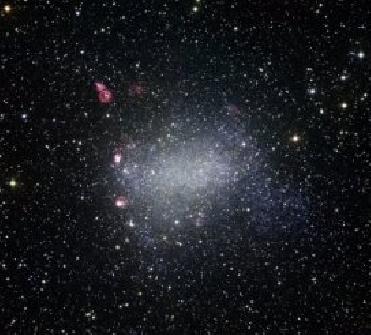
Bernard Galaxy, also named NGC 6822, as captured by ESO's telescope at La Silla Observatory in northern Chile. Image credit: ESO
PARIS (BNS): Astronomers at the European Southern Observatory (ESO) have obtained a stunning image of one of our nearest galactic neighbours – the Barnard's Galaxy – which contains regions of rich star formation and majestic nebulae.
The galaxy, also named NGC 6822, has been classified as an irregular dwarf galaxy due to its “odd” shape and relatively diminutive size by galactic standards. The “strange shapes” of these cosmic misfits help researchers understand how galaxies interact, evolve and occasionally “cannibalise” each other, leaving behind radiant, star-filled scraps, the ESO said.
The latest image shows the Barnard’s Galaxy “glowing beneath a sea of foreground stars” in the direction of the constellation of Sagittarius. At a relatively close distance of about 1.6 million light-years, the galaxy is a member of the Local Group – the archipelago of galaxies that includes our home, the Milky Way.
It has derived its name from its discoverer, American astronomer Edward Emerson Barnard, who first spotted this visually elusive cosmic islet in 1884.
The latest image of the galaxy was captured using a Wide Field Imager (WFI) attached to the 2.2-metre MPG/ESO telescope at ESO’s La Silla Observatory in northern Chile.
Even though Barnard’s Galaxy lacks the majestic spiral arms and glowing, central bulge that grace its big galactic neighbours – the Milky Way, the Andromeda and the Triangulum galaxies – this dwarf galaxy has no shortage of stellar splendour and pyrotechnics.
Reddish nebulae in this image reveal regions of active star formation, where young, hot stars heat up nearby gas clouds. Also prominent in the upper left of the image is a striking bubble-shaped nebula. At the nebula’s centre, a clutch of massive, scorching stars send waves of matter smashing into the surrounding interstellar material, generating a glowing, ring-like structure. Other similar ripples of heated matter thrown out by feisty young stars are dotted across the galaxy.
Only about a 10th of the Milky Way’s size, Barnard’s Galaxy contains about 10 million stars – far less than our home galaxy’s estimated 400 billion. In the Local Group, as elsewhere in the Universe, however, dwarf galaxies outnumber their larger, shapelier cousins.
 Previous Article
Previous Article













The Indian Air Force, in its flight trials evaluation report submitted before the Defence Ministry l..
view articleAn insight into the Medium Multi-Role Combat Aircraft competition...
view articleSky enthusiasts can now spot the International Space Station (ISS) commanded by Indian-American astr..
view article